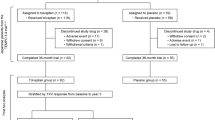Abstract
Background
A recent study demonstrated that tolvaptan slowed estimated glomerular filtration rate (eGFR) decline in later-stage autosomal dominant polycystic kidney disease (ADPKD) patients. However, Japanese patients were not included in that trial, therefore tolvaptan’s efficacy in Japanese patients with advanced chronic kidney disease (CKD) has remained unknown.
Methods
In this prospective cohort study, 54 patients with ADPKD who had eGFR ≥ 15 ml/min/1.73 m2 and total kidney volume (TKV) ≥ 750 ml were treated with tolvaptan. The primary endpoint was the change in height-adjusted total kidney volume (htTKV) and eGFR after 1-year treatment with tolvaptan. Then, we compared the primary endpoint between later CKD stage (baseline eGFR < 45 ml/min/1.73 m2) and earlier CKD stage (baseline eGFR ≥ 45 ml/min/1.73 m2).
Results
The rate of kidney growth during the 1-year treatment did not differ significantly between earlier and later CKD stages. The median and interquartile range of relative change in htTKV in later CKD stage was 8.2%/year [4.4, 26.6], as compared with 5.7%/year [1.6, 16.4] in earlier CKD stage (p = 0.17). Nor did the rate of eGFR decline between earlier and later CKD stages. The relative annual change in eGFR in later CKD stage was − 9.7%/year [− 15.9, − 2.1], as compared with − 6.8%/year [− 11.1, 0.1] in earlier CKD stage (p = 0.18).
Conclusion
This analysis indicates that the efficacy of tolvaptan for Japanese patients with later stage ADPKD was not significantly different from that of Japanese patients with earlier stage ADPKD.



Similar content being viewed by others
References
Torres VE, Harris PC, Pirson Y (2007) Autosomal dominant polycystic kidney disease. Lancet 369:1287–1301
Grantham JJ (2008) Clinical practice. Autosomal dominant polycystic kidney disease. N Engl J Med 359:1477–1485
Muto S, Kawano H, Higashihara E, Narita I, Ubara Y, Matsuzaki T et al (2015) The effect of tolvaptan on autosomal dominant polycystic kidney disease patients: a subgroup analysis of the Japanese patient subset from TEMPO 3:4 trial. Clin Exp Nephrol 19:867–877
Ubara Y, Tagami T, Sawa N, Katori H, Yokota M, Takemoto F et al (2002) Renal contraction therapy for enlarged polycystic kidneys by transcatheter arterial embolization in hemodialysis patients. Am J Kidney Dis 39(3):571–579
Junichi Hoshino T, Suwabe N, Hayami, Keiichi S, Yoshifumi U et al (2015) Survival after arterial embolization therapy in patients with polycystic kidney and liver disease. J Nephrol 28(3):369–377
Iliuta IA, Kitchlu A, Pei Y (2017 Jun) Methodological issues in clinical trials of polycystic kidney disease: a focused review. J Nephrol 30(3):363–371
Torres VE, Chapman AB, Devuyst O, Gansevoort RT, Grantham JJ, Higashihara E et al (2012) Tolvaptan in patients with autosomal dominant polycystic kidney disease. N Engl J Med 367:2407–2418
Grantham JJ, Torres VE, Chapman AB et al (2006) Volume progression in polycystic kidney disease. N Engl J Med 354:2122–2130
Torres VE, Chapman AB, Devuyst O, Gansevoort RT, Perrone RD, Koch G et al (2017) Tolvaptan in later-stage autosomal dominant polycystic kidney disease. N Engl J Med 377:1930–1942
Bakris G, Bursztyn M, Gavras I, Bresnahan M, Gavras H (1997) Role of vasopressin in essential hypertension: racial differences. J Hypertens 15(5):545–550
Pei Y, Obaji J, Dupuis A, Paterson AD, Magistroni R, Dicks E, Parfrey P, Cramer B, Coto E, Torra R, San Millan JL, Gibson R, Breuning M, Peters D, Ravine D (2009) Unified criteria for ultrasonographic diagnosis of ADPKD. J Am Soc Nephrol 20:205–212
Pei Y (2006) Diagnostic approach in autosomal dominant polycystic kidney disease. Clin J Am Soc Nephrol 1:1108–1114
Matsuo S, Imai E, Horio M, Yasuda Y, Tomita K, Nitta K, Yamagata K, Tomino Y, Yokoyama H, Hishida A (2009) Revised equations for estimated GFR from serum creatinine in Japan. Am J Kidney Dis 53:982–992
Ubara Y, Tagami T, Sawa N, Katori H, Yokota M, Takemoto F, Inoue S, Kuzuhara K, Hara S, Yamada A (2009) Renal contraction therapy for enlarged polycystic kidneys by transcatheter arterial embolization in hemodialysis patients. Am J Kidney Dis 39:571–579
Suwabe T, Ubara Y, Mise K, Ueno T, Sumida K, Yamanouchi M, Hayami N, Hoshino J, Kawada M, Imafuku A, Hiramatsu R, Hasegawa E, Sawa N, Takaichi K (2015) Suitability of patients with autosomal dominant polycystic kidney disease for renal transcatheter arterial embolization. J Am Soc Nephrol 27:2177–2187
Higashihara E, Nutahara K, Okegawa T, Tanbo M, Hara H, Miyazaki I, Kobayasi K, Nitatori T (2015) Kidney volume estimations with ellipsoid equations by magnetic resonance imaging in autosomal dominant polycystic kidney disease. Nephron 129:253–262
Acknowledgements
This work was supported by JH’s research grants from Grants-in-Aid for Scientific Research (JSPS KAKENHI) Grant number 15K08719 and 18K08227, the Okinaka Memorial Institute, The Kidney Foundation Japan (JKFB 15–23), and Toranomon Hospital. No funding bodies had any role in study design, data analysis, decision to publish, or preparation of the manuscript.
Author information
Authors and Affiliations
Corresponding author
Ethics declarations
Conflict of interst
The authors declare that they have no conflicts of interest.
Ethical approval
All procedures performed in studies involving human participants were in accordance with the ethical standards of the institutional research committee at which the studies were conducted (IRB approval number 840) and with the 1964 Helsinki declaration and its later amendments or comparable ethical standards.
Informed consent
Informed consent was obtained from all individual participants included in the study.
Rights and permissions
About this article
Cite this article
Oguro, M., Kogure, Y., Hoshino, J. et al. Tolvaptan in Japanese patients with later-stage autosomal dominant polycystic kidney disease. J Nephrol 31, 961–966 (2018). https://doi.org/10.1007/s40620-018-0545-8
Received:
Accepted:
Published:
Issue Date:
DOI: https://doi.org/10.1007/s40620-018-0545-8




